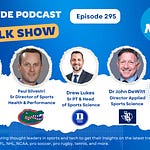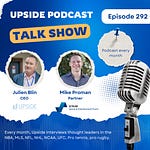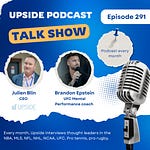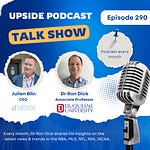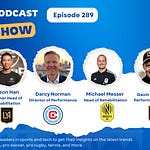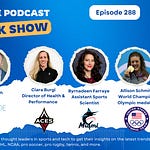Today we have the honor of interviewing Dr Trent Nessler, a sports physical therapist, with an expertise in ACL injuries and Mixed Martial Art.
Trent Nessler, PT, MPT, DPT is owner of The Athlete Lab, a sports rehab facility specializing in ACL rehab, MMA/ BJJ and mature athletes. The Athlete Lab is an operating research facility and one of the few in the US specializing in ACL Return to Play & MMA/BJJ. Dr. Nessler is a nationally recognized sports medicine physical therapist, movement science specialist, innovator with over 25 years of clinical experience and Brazilian Jiu Jitsu Black Belt. He is a driven leader bringing the latest in sports science, research and technology to athletes all over the world. He has spent his entire career advancing the knowledge, techniques and products used to prevent injuries in athletics and tactical athletes. With several internationally successful commercial products, Dr. Nessler's programs have impacted 100,000+ active individuals across 5 countries.
Dr. Nessler is also the co-founder and developer of ViMove+ AMI and ViPerform AMI, two cutting-edge applications that use wearable sensors (DorsaVi) to analyze and improve human movement for injury prevention and performance enhancement. This technology has been used to assess 70,000+ athletes in sports at all levels across 5 countries and is the largest objective movement database in the world. This has lead to advanced knowledge related to athletic movement and how to develop more effective programing to improve.
📝Show Notes: Through this interview, we touched on his background, his practice, and his expertise and research in ACL rehabilitation. We also discussed how technologies can play in the future of rehab, especially ACL injuries. He also touched on the type of technology he would build if he had unlimited resources.
You can read the full transcript of the podcast interview with Trent located at the top of this blog post.
Here are the quotes from the interview with Trent:
Q1. Tell me about your background.
"I’m a sports physical therapist. I’ve been a PT for about 25 years now. I really got interested in ACL injuries probably a little over 20 years ago, and as a clinician, I wanted to develop a way to assess athletes better for ACL risk. Long story short, I partnered with a company called Dorsa VI out of Australia in 2017, and we commercialized what is now known as the VMO Plus AMI (Athletic Movement Index)."
"Since then, we’ve had multiple iterations of the system, and now it’s in five different countries. We’ve collected biomechanical data on over 90,000 athletes, and it’s been incredibly exciting. I’ve learned a ton about human movement—things I never knew before—and it’s had a huge impact on my clinical experience and on the programs we’ve developed to help athletes."
Q2. Tell me about your practice.
"Recently, we launched a continuing education program for ACL-certified specialists. This program is designed for physical therapists treating ACL patients, helping them understand how to truly impact human movement. It’s a mix of online and in-person courses, and we’ve included components like blood flow restriction training, neurocognitive training, and rotational training. We’re even collaborating with companies like Kaizen Vector to incorporate new equipment into these programs."
"What’s been fascinating for me is the ability to measure the impact of our interventions. Using data, I can see whether my programs are truly making a difference in correcting the movement patterns that put athletes at risk. For example, the research shows that traditional rehab often doesn’t address biomechanical risk factors for ACL injuries, like dynamic valgus, effectively enough. So, we’re focusing on creating and testing new methods to address those issues."
Q3. You have an expertise in ACL rehabilitation. Can you tell me more about that and the research you have done in the space?
"What we know from research is that when athletes return to sport after ACL reconstruction—typically at nine months—they’re still showing a lot of biomechanical risk factors for reinjury, like dynamic valgus. Studies also show that even two years post-return to play, these risks are still present. That’s a major concern because it means our traditional rehab methods aren’t fully addressing these issues."
"Part of what we’re doing is using data to develop better programs that measure changes in specific areas like dynamic valgus, pelvic control, and single-limb performance. For example, if an athlete’s movement deteriorates under fatigue, we use blood flow restriction (BFR) training to simulate that fatigue state and see where their movement breaks down. This helps us create more targeted interventions to address those weak points."
"We also measure kinesiophobia, or fear of movement, using the Tampa Scale for Kinesiophobia. This fear is highly correlated with reinjury risk, quadriceps deficits, and movement dysfunction. So, addressing the mental and physical aspects of rehab is key to reducing the chances of reinjury."
Q4. What role do you think technologies can play in the future of rehab, especially ACL injuries?
"To me, if you’re not using technology for rehab, you’re missing the boat. Since we created the VMO Plus AMI, we’ve generated over 320 million data points related to human movement. This has allowed us to create much better, more effective programming that’s also highly customized to individual athletes."
"One thing we know is that physical therapists aren’t as good at assessing movement as we like to think we are. By leveraging technology—like sensor-based platforms and computer vision—we can become much more efficient and precise in how we evaluate and treat athletes."
"For example, I use blood flow restriction training combined with red light therapy in my clinic. BFR helps increase motor unit recruitment and releases growth hormones, while red light accelerates protein synthesis. Together, these technologies significantly improve the efficiency of my rehab protocols and help athletes recover faster and more effectively."
Q5. If you could build any technologies, what would it be? Why?
"My passion has always been preventing ACL injuries, especially in kids. If I could build anything, it would be an AI platform that uses markerless biomechanics to assess athletes’ movement patterns. I’d gamify the training process, creating interactive games that encourage athletes to perform single-limb exercises while correcting their movement patterns in real time."
"This kind of technology would serve two purposes: it would improve athletes’ overall performance, and it would mitigate their risk for ACL injuries. By addressing these biomechanical deficits early on, we could have a huge impact on both injury prevention and long-term athletic development."
You may also like:





